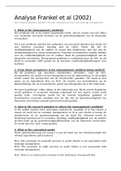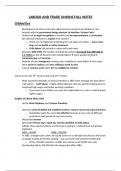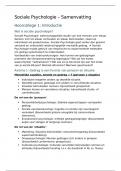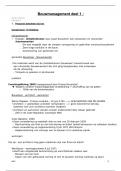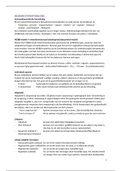International Business Awareness
Week 1
CH13: Evaluation of countries for operations
Location is the most import factor in international business. Because all companies have limited
resources, they must be careful in making the following decisions:
1. The location of sales, production and administrative/auxiliary services
2. The sequence for entering different countries
3. The portion of resources and efforts to allocate to each country where they operate
Companies need to:
Determine the order of country entry
Set the rates of resource allocation among countries
Main reasons to go abroad are to spread risk (1) to reduce costs (2) to gain sales (3)
Step 1: Scanning - the process by which managers examine many countries broadly and the narrow
them down to the most promising ones (cheap)
Step 2: Detailed analysis - compare feasibility and desirability of countries (resource intensive)
Escalation of commitment – the more time and money companies invest in examining the alternative,
the more likely they are to accept it, regardless of its merits.
Opportunities: Sales Expansion Opportunities: Resource Acquisition
- GDP and population Cost considerations:
- Economic and demographic variables: - Labour
Leapfrogging of products - Infrastructure
Prices - Ease of transport and communications
Income elasticity - Government incentives and disincentives
Substitution
Income inequality
Cultural factors and taste
Existence of trading blocs
Risks:
1. Companies and managers have differences in their perceptions of risk.
2. One company’s risk is another’s opportunity.
3. Reducing risk other than avoiding location.
4. There are always trade-offs.
Risk aspects:
1. Competitive risk.
- Making operations comparable.
- Geographic diversification.
- Following competitors or customers.
2. Monetary risk.
- Exchange rate stability.
- Inflation rates.
- Liquidity preference.
- Capita; controls.
- Government spending
3. Political risk.
- Changes in government policy.
- Operational issues.
- Nationalization.
4. Natural disasters.
,!!! Location decisions affecting international operations: tools: SWOT / PESTLE/STEEPLE
S – Social: cultural and demographic change can directly affect the activities of a business. E.g.
increase in the number of working mothers, rise of disposable fashion, animal right movement.
T – Technological: the fast-changing technological environment presents constant threats and
opportunities for a business. Technology affects all aspects of business functions.
E – Economic: these are factors such as interest rates, economic growth, employment, international
trade and state of infrastructure.
E – Ethics: the moral principle that are, or should be, considered in business decision-making.
L – Legal: governments will impose laws and regulations to limit the adverse effects of business
activity on the general public. Legislation will can also be passed to protect businesses.
P – Political: political stability of a country and government policies will provide opportunities and
threats for a business.
E – Environmental: individuals, organizations and governments are increasingly concerned about the
impact of business activity on the environment.
Country selection tool: The Grid
, Example Booking.com The Opportunity-risk Matrix:
Indices:
- MPI index
- Economic freedom index
- Corruption perception index
Assessing market potential: {PGM x LP – (BC + Av + U + BD +
Aff)} x PD x US x PL
- PGM = people in geographic market.
- LP = logical potentials
- BC = benefit comprehension
- Av = availability
- U = usability
- BD = benefit deficiency
- Aff. = affordability
- PD = penetration
- US = usage rate
- PL = price level
Potential market size = number of consumers in geographic market x % of logical potentials
you can lose potential because: they don’t understand / they can't get it / they can’t use it / they're not
convinced of the benefits / they can’t pay the price (or are not willing to).
Country evaluation
Quantitative Risk issues Qualitative
- Market size and - Political risk - Competition
development - Competitive risk - Distribution
- Sales potential - Monetary risk - Suppliers
- Cost and resource - Natural disaster - Trends
availability - Consumer behavior
Data Sources (for the grid)
Market research / consultants
Government agencies
International organizations
Trade associations
Data Quality Issues
Accuracy – governmental resources may limit accurate data collection
Corruption – governments may purposely publish misleading information
Response bias – respondents may give false information to data collectors
Black market activity – official data may include only legal and reported market activities
Methodological issues – poor methodology may be used
Week 1
CH13: Evaluation of countries for operations
Location is the most import factor in international business. Because all companies have limited
resources, they must be careful in making the following decisions:
1. The location of sales, production and administrative/auxiliary services
2. The sequence for entering different countries
3. The portion of resources and efforts to allocate to each country where they operate
Companies need to:
Determine the order of country entry
Set the rates of resource allocation among countries
Main reasons to go abroad are to spread risk (1) to reduce costs (2) to gain sales (3)
Step 1: Scanning - the process by which managers examine many countries broadly and the narrow
them down to the most promising ones (cheap)
Step 2: Detailed analysis - compare feasibility and desirability of countries (resource intensive)
Escalation of commitment – the more time and money companies invest in examining the alternative,
the more likely they are to accept it, regardless of its merits.
Opportunities: Sales Expansion Opportunities: Resource Acquisition
- GDP and population Cost considerations:
- Economic and demographic variables: - Labour
Leapfrogging of products - Infrastructure
Prices - Ease of transport and communications
Income elasticity - Government incentives and disincentives
Substitution
Income inequality
Cultural factors and taste
Existence of trading blocs
Risks:
1. Companies and managers have differences in their perceptions of risk.
2. One company’s risk is another’s opportunity.
3. Reducing risk other than avoiding location.
4. There are always trade-offs.
Risk aspects:
1. Competitive risk.
- Making operations comparable.
- Geographic diversification.
- Following competitors or customers.
2. Monetary risk.
- Exchange rate stability.
- Inflation rates.
- Liquidity preference.
- Capita; controls.
- Government spending
3. Political risk.
- Changes in government policy.
- Operational issues.
- Nationalization.
4. Natural disasters.
,!!! Location decisions affecting international operations: tools: SWOT / PESTLE/STEEPLE
S – Social: cultural and demographic change can directly affect the activities of a business. E.g.
increase in the number of working mothers, rise of disposable fashion, animal right movement.
T – Technological: the fast-changing technological environment presents constant threats and
opportunities for a business. Technology affects all aspects of business functions.
E – Economic: these are factors such as interest rates, economic growth, employment, international
trade and state of infrastructure.
E – Ethics: the moral principle that are, or should be, considered in business decision-making.
L – Legal: governments will impose laws and regulations to limit the adverse effects of business
activity on the general public. Legislation will can also be passed to protect businesses.
P – Political: political stability of a country and government policies will provide opportunities and
threats for a business.
E – Environmental: individuals, organizations and governments are increasingly concerned about the
impact of business activity on the environment.
Country selection tool: The Grid
, Example Booking.com The Opportunity-risk Matrix:
Indices:
- MPI index
- Economic freedom index
- Corruption perception index
Assessing market potential: {PGM x LP – (BC + Av + U + BD +
Aff)} x PD x US x PL
- PGM = people in geographic market.
- LP = logical potentials
- BC = benefit comprehension
- Av = availability
- U = usability
- BD = benefit deficiency
- Aff. = affordability
- PD = penetration
- US = usage rate
- PL = price level
Potential market size = number of consumers in geographic market x % of logical potentials
you can lose potential because: they don’t understand / they can't get it / they can’t use it / they're not
convinced of the benefits / they can’t pay the price (or are not willing to).
Country evaluation
Quantitative Risk issues Qualitative
- Market size and - Political risk - Competition
development - Competitive risk - Distribution
- Sales potential - Monetary risk - Suppliers
- Cost and resource - Natural disaster - Trends
availability - Consumer behavior
Data Sources (for the grid)
Market research / consultants
Government agencies
International organizations
Trade associations
Data Quality Issues
Accuracy – governmental resources may limit accurate data collection
Corruption – governments may purposely publish misleading information
Response bias – respondents may give false information to data collectors
Black market activity – official data may include only legal and reported market activities
Methodological issues – poor methodology may be used





